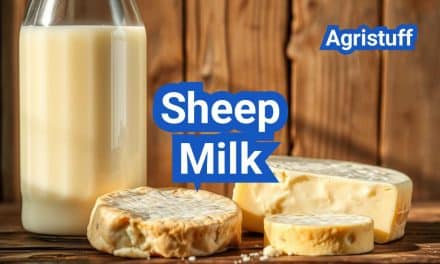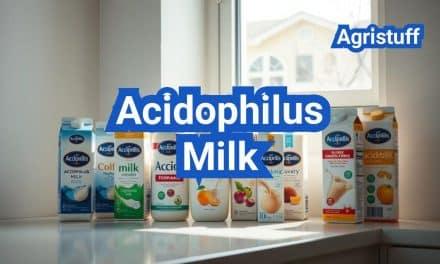Dairy products are food items derived from the milk of mammals, such as cows, goats, and sheep. These nutritious foods include fluid milk, cheese, and ice cream, offering various health benefits.
The diverse range of dairy products caters to different tastes and dietary needs. For instance, fluid milk is a rich source of calcium, while cheese is high in protein. Ice cream, on the other hand, is a popular treat that can be enjoyed in moderation.
Key Takeaways
- Dairy products are made from the milk of mammals.
- Fluid milk, cheese, and ice cream are common dairy products.
- Dairy products offer various nutritional benefits.
- Milkfat percentage varies across different dairy products.
- A comprehensive dairy products list includes a range of items.
Understanding Dairy Products and Their Importance
With their high nutritional value, dairy products are a crucial component of a balanced diet. Dairy products encompass a wide range of foods derived from milk, including fluid milk, cheese, yogurt, and ice cream. These products are rich in essential nutrients such as calcium, protein, and vitamins D and B12.
What Qualifies as a Dairy Product
Dairy products are defined as foods that come from mammary glands of mammals, primarily cows, goats, and sheep. The USDA categorizes dairy products into several groups, including fluid milk, cultured products like yogurt, cheese, and frozen dairy desserts.
Nutritional Significance in American Diet
Dairy products contribute significantly to the American diet by providing vital nutrients. Calcium is crucial for bone health, while protein supports muscle growth and repair. Vitamins D and B12, found abundantly in dairy, play roles in bone health and neurological function, respectively.
USDA MyPlate Dairy Recommendations
The USDA MyPlate guidelines recommend that adults consume three cups of dairy products daily. The dairy group includes milk, yogurt, cheese, and fortified soy milk and yogurt. The recommendations aim to help individuals make informed choices about their dairy intake to support overall health.
| Dairy Product | Serving Size | Nutritional Highlights |
|---|---|---|
| Fluid Milk | 1 cup | Calcium, Vitamin D, Protein |
| Yogurt | 6 oz | Protein, Calcium, Probiotics |
| Cheese | 1.5 oz | Calcium, Protein, Vitamin B12 |
By understanding the importance of dairy products and following the USDA MyPlate guidelines, individuals can make healthier dietary choices that support their nutritional needs.
Complete Dairy Products List with Categories and Examples

The dairy products list is diverse, including various categories that cater to different tastes and dietary needs. Dairy products are a significant part of many diets around the world, providing essential nutrients and versatility in culinary applications.
Fluid Milk Products
Fluid milk products are a primary category of dairy products. They include:
- Whole milk
- Reduced-fat milk
- Low-fat milk
- Skim milk
- Flavored milk (e.g., chocolate, strawberry)
Cultured and Fermented Dairy
Cultured and fermented dairy products offer unique flavors and health benefits. Examples include:
- Yogurt (plain and flavored)
- Kefir
- Buttermilk
- Sour cream
Cheese Varieties
Cheese is a diverse category with numerous varieties, including:
- Soft cheeses (e.g., brie, feta)
- Semi-soft cheeses (e.g., mozzarella, Monterey Jack)
- Semi-hard cheeses (e.g., Gouda, Edam)
- Hard cheeses (e.g., cheddar, Parmesan)
Cream-Based Products
Cream-based products are rich in fat and add flavor and texture to various dishes. They include:
- Half-and-half
- Heavy cream
- Whipping cream
- Sour cream
To better understand the nutritional differences among these categories, let’s examine a comparison table:
| Category | Examples | Typical Fat Content | Common Uses |
|---|---|---|---|
| Fluid Milk Products | Whole milk, Skim milk | 0-8% fat | Cereals, cooking, drinking |
| Cultured and Fermented Dairy | Yogurt, Kefir | 0-10% fat | Snacks, smoothies, desserts |
| Cheese Varieties | Cheddar, Mozzarella | 5-40% fat | Pizzas, sandwiches, salads |
| Cream-Based Products | Heavy cream, Sour cream | 10-80% fat | Sauces, desserts, dips |
Fluid Milk: Types, Processing, and Nutrition
Understanding the different types of fluid milk is essential for making informed dietary choices. Fluid milk comes in various forms, each with its own set of characteristics and nutritional benefits.
Whole, Reduced-Fat, Low-Fat, and Skim Milk
Fluid milk is categorized based on its fat content into whole, reduced-fat, low-fat, and skim milk. Whole milk contains about 3.5% fat, while reduced-fat milk has 2% fat, low-fat milk contains 1% fat, and skim milk has almost no fat, typically less than 1%.
The milkfat percentage in milk not only affects its taste and texture but also its nutritional profile. Consumers can choose a type of milk that suits their dietary needs, whether they’re looking for a richer taste or a lower-fat option.
Milkfat Percentage Explained
The milkfat percentage is a critical factor in determining the nutritional content of milk. Milk with higher fat content tends to have more calories and fat-soluble vitamins. However, lower-fat versions are often preferred for their reduced calorie count.
| Type of Milk | Milkfat Percentage | Calories per Cup |
|---|---|---|
| Whole Milk | 3.5% | 170 |
| Reduced-Fat Milk | 2% | 120 |
| Low-Fat Milk | 1% | 100 |
| Skim Milk | <1% | 80 |
Pasteurization Standards and Safety
Pasteurization is a critical process that ensures the safety of fluid milk by killing harmful bacteria. The pasteurization process involves heating the milk to a high temperature for a short period, followed by rapid cooling.
This process not only enhances safety but also extends the shelf life of milk. All fluid milk products, regardless of their fat content, undergo pasteurization to meet safety standards.
Nutritional Profile of Different Milk Types
The nutritional profile of milk varies significantly with its fat content. While whole milk is rich in fat-soluble vitamins, lower-fat milks are preferred for their lower calorie and fat content. Skim milk, for instance, is an excellent source of protein and calcium without the fat.
Regardless of the type, fluid milk is a nutritious beverage that provides essential nutrients, including calcium, vitamin D, and protein, making it a valuable part of a balanced diet.
Dairy Nutrition Facts: Essential Components and Benefits

Understanding dairy nutrition facts is crucial for appreciating its role in a healthy diet. Dairy products are rich in a variety of nutrients that are essential for overall health and well-being.
Macronutrient Composition of Dairy
Dairy products contain a mix of macronutrients, including proteins, fats, and carbohydrates. The protein in dairy is of high quality, containing all essential amino acids necessary for the body. Dairy fat, particularly in full-fat products, is a source of energy and aids in the absorption of fat-soluble vitamins.
The carbohydrate content in dairy primarily comes in the form of lactose, a disaccharide that is broken down into glucose and galactose during digestion. The macronutrient composition can vary significantly across different dairy products, with variations in fat content being a key differentiator.
Micronutrients in Dairy Products
Dairy is an excellent source of several micronutrients, including calcium, phosphorus, potassium, and vitamins D and B12. Calcium is crucial for bone health, while phosphorus plays a key role in the formation of bones and teeth, as well as in the body’s energy production.
- Calcium: Essential for bone health and development.
- Vitamin D: Important for calcium absorption and bone health.
- Potassium: Helps in maintaining healthy blood pressure.
- Vitamin B12: Crucial for nerve function and the production of red blood cells.
Dairy’s Role in Bone Health
The nutrients in dairy products, particularly calcium and vitamin D, play a significant role in bone health. Adequate intake of these nutrients during childhood and adolescence is crucial for achieving peak bone mass, reducing the risk of osteoporosis and fractures later in life.
“Dairy products are a rich source of calcium, vitamin D, and other nutrients essential for bone health.” –
Nutrition Expert
Potential Health Benefits of Dairy Consumption
Consuming dairy products has been associated with several potential health benefits, including improved bone health, reduced risk of osteoporosis, and a lower risk of cardiovascular disease. The nutrients in dairy can also support weight management and overall nutritional status.
It’s worth noting that the health benefits of dairy can vary depending on the type of dairy product consumed. Choosing a variety of dairy products, including those that are low in fat and rich in nutrients, can help maximize these benefits.
Cultured Dairy Products: Yogurt, Kefir, and Beyond
With their rich history and health benefits, cultured dairy products have become a staple in many diets. These products, which include yogurt, kefir, and other fermented dairy items, offer a range of flavors and textures that cater to diverse consumer preferences.
Yogurt Types and Cultures
Yogurt is one of the most popular cultured dairy products, known for its creamy texture and tangy flavor. It is made by adding bacterial cultures to milk, which ferment the lactose and produce lactic acid. There are various types of yogurt, including Greek yogurt, Icelandic yogurt (skyr), and drinkable yogurt, each with its unique characteristics and nutritional profile.
The bacterial cultures used in yogurt production, typically Lactobacillus bulgaricus and Streptococcus thermophilus, are responsible for its fermentation. Some yogurts may also contain additional probiotic strains, such as Lactobacillus acidophilus or Bifidobacterium bifidum, which can provide additional health benefits.
Kefir vs. Yogurt: Differences and Benefits
Kefir is another type of cultured dairy product that is similar to yogurt but has a thinner consistency and a wider variety of bacterial and yeast cultures. Kefir grains, which are used to ferment the milk, contain a complex mixture of microorganisms that can provide a broader range of probiotic benefits compared to traditional yogurt cultures.
According to a study published in the
Journal of Dairy Science
, kefir has been shown to have potential health benefits, including improved digestion and enhanced immune function. While both kefir and yogurt offer probiotic benefits, kefir’s diverse microbial profile may make it a more effective option for some consumers.
Other Cultured Dairy Products
Beyond yogurt and kefir, there are several other cultured dairy products that offer unique flavors and nutritional benefits. These include buttermilk, sour cream, and crème fraîche, which are often used in cooking and baking. Each of these products has its own distinct characteristics and can add depth and complexity to various recipes.
Probiotic Benefits of Fermented Dairy
The probiotic benefits of fermented dairy products, including yogurt, kefir, and other cultured items, are well-documented. These products contain live microorganisms that can help support gut health, boost the immune system, and even produce certain vitamins. As noted by the
National Yogurt Association
, “the probiotic cultures in yogurt and other fermented dairy products can help maintain a healthy balance of gut bacteria.”
Incorporating cultured dairy products into one’s diet can be a simple and effective way to support overall health and well-being. With their rich flavors and numerous health benefits, these products are a great addition to a balanced diet.
Cheese: From Fresh to Aged Varieties

Cheese, a staple in many cuisines, comes in a wide range of varieties, from fresh to aged, each with its unique characteristics. The diversity in cheese types is not just about the taste; it’s also about the texture, production process, and usage in different culinary contexts.
Fresh Cheese Types
Fresh cheese, such as ricotta, cottage cheese, and cream cheese, is known for its mild flavor and soft texture. These cheeses are often used in desserts, spreads, and as ingredients in various recipes. Fresh cheese types are typically made with minimal aging and have a higher moisture content compared to aged cheeses.
Semi-Soft and Semi-Hard Cheeses
Semi-soft cheeses like mozzarella and Monterey Jack are popular for their melting properties, making them ideal for pizzas and grilled cheese sandwiches. Semi-hard cheeses, such as Gouda and Edam, offer a balance between flavor and texture, suitable for snacking and cooking.
Hard and Aged Cheeses
Hard and aged cheeses, including Parmesan and cheddar, are known for their rich, intense flavors developed through the aging process. These cheeses are often grated over dishes or served as a table cheese. The aging process concentrates the flavors, making them stronger and more complex.
Cheddar vs. Mozzarella: Composition and Uses
Cheddar and mozzarella are two popular cheeses with distinct compositions and uses. Cheddar, a firm cheese with a sharp flavor, is commonly used in sandwiches, soups, and as a grated cheese. Mozzarella, known for its melting properties, is a staple in Italian cuisine, particularly for pizzas and caprese salads. The difference in their fat content and moisture levels contributes to their unique characteristics and applications.
In conclusion, the world of cheese is incredibly diverse, with varieties ranging from fresh to aged, each with its own set of characteristics and culinary uses. Understanding these differences can enhance one’s appreciation and use of cheese in cooking.
Cream Products: From Half-and-Half to Whipping Cream

Cream products, varying from light cream to heavy whipping cream, are essential in both cooking and baking. These dairy products are valued for their rich texture and versatility in both sweet and savory dishes.
Half-and-Half Fat Content and Uses| Dairy Products List
Half-and-half is a mixture of milk and cream, containing between 10.5% and 18% milkfat. It is often used in coffee, soups, and sauces to add richness without the heaviness of heavy cream. The fat content makes it an excellent addition to recipes where a creamy texture is desired without overpowering other flavors.
Light, Heavy, and Whipping Cream Differences| Dairy Products List
Light cream contains about 20% milkfat, making it suitable for soups and sauces. Heavy cream, with a minimum of 36% milkfat, is ideal for whipping and desserts. Whipping cream is similar to heavy cream but may contain stabilizers to improve its whipping properties. The differences in fat content affect their usage in recipes and their nutritional profiles.
Sour Cream Fat Content and Production| Dairy Products List
Sour cream is made by adding bacterial culture to cream, giving it a tangy flavor. It typically contains around 18% to 20% milkfat. Sour cream is used in baking, as a topping for dishes like baked potatoes, and as an ingredient in dips and sauces.
Crème Fraîche and Specialty Creams| Dairy Products List
Crème fraîche is a type of sour cream with a higher fat content (around 30-40%) and a milder flavor. It’s used in both sweet and savory dishes, adding a rich, creamy texture. Other specialty creams include flavored creams and creams with added stabilizers for specific culinary uses.
| Cream Product | Milkfat Content (%) | Common Uses |
|---|---|---|
| Half-and-Half | 10.5 – 18 | Coffee, soups, sauces |
| Light Cream | 20 | Soups, sauces |
| Heavy Cream | 36+ | Whipping, desserts |
| Sour Cream | 18 – 20 | Baking, dips, toppings |
| Crème Fraîche | 30 – 40 | Sweet and savory dishes |
Butter and Butter-Based Products

With its rich flavor and versatility, butter is a fundamental ingredient in cooking and baking. The process of making butter involves churning cream until the fat globules separate and clump together, resulting in a product with a minimum of 80% milkfat.
Production and 80% Milkfat Standard| Dairy Products List
Butter production starts with cream, which is rich in fat globules. The cream is churned or agitated until the fat globules break apart and then clump together, forming butter grains. The remaining liquid is buttermilk. The butter is then worked to remove any remaining buttermilk and to achieve the desired consistency. The 80% milkfat standard is a critical characteristic of butter, distinguishing it from other dairy products.
Salted vs. Unsalted Butter| Dairy Products List
Butter can be categorized into two main types based on its salt content: salted and unsalted. Salted butter contains added salt, which enhances flavor and acts as a preservative. Unsalted butter, on the other hand, is preferred by many bakers and chefs because it allows for better control over the amount of salt in recipes.
- Salted butter is ideal for savory dishes and as a spread.
- Unsalted butter is often used in baking and cooking where salt content needs to be controlled.
Cultured and European-Style Butter| Dairy Products List
Cultured butter is made by adding bacterial cultures to the cream before churning, giving it a distinct, tangy flavor. European-style butter often has a higher fat content than regular butter, typically around 86% milkfat, and is known for its rich, creamy taste.
- Cultured butter adds a unique flavor dimension to dishes.
- European-style butter is preferred for its rich taste and higher milkfat content.
Ghee and Clarified Butter| Dairy Products List
Ghee and clarified butter are types of butter that have been heated to separate the butterfat from the milk solids, resulting in a clear, golden liquid with a high smoke point. Ghee, in particular, is often used in Indian cuisine and has a nutty flavor due to the caramelization of the milk solids during its production.
- Ghee is used in high-heat cooking due to its high smoke point.
- Clarified butter is often used in sauces and cooking where a clear, butterfat-only product is desired.
Understanding the different types of butter and their uses can elevate cooking and baking. Whether it’s salted, unsalted, cultured, or clarified, each type of butter brings its unique characteristics to the table.
Concentrated and Dried Dairy Products

From evaporated milk to whey protein concentrate, concentrated and dried dairy products are versatile ingredients used in a variety of culinary applications. These products are made by removing water from milk or other dairy products, resulting in a more concentrated form that can be stored for longer periods.
Evaporated vs. Condensed Milk Differences| Dairy Products List
Evaporated milk and condensed milk are two popular concentrated dairy products that differ significantly in their production process and uses. Evaporated milk is made by removing about 60% of the water from milk, resulting in a creamy texture and mild flavor. It is often used in recipes where a rich texture is desired without the sweetness.
Condensed milk, on the other hand, is made by removing about 60% of the water from milk and then adding a large amount of sugar. This process gives condensed milk its characteristic sweet flavor and thick consistency. It is commonly used in desserts and sweet dishes.
| Product | Production Process | Common Uses |
|---|---|---|
| Evaporated Milk | Water removal (about 60%) | Recipes requiring a rich texture without sweetness |
| Condensed Milk | Water removal (about 60%) + sugar addition | Desserts and sweet dishes |
Nonfat Dry Milk Uses and Applications| Dairy Products List
Nonfat dry milk is another concentrated dairy product made by removing almost all the fat and water from milk. It is a popular ingredient in baking, cooking, and food production due to its long shelf life and nutritional value.
Some common uses of nonfat dry milk include:
- Baking: Adds moisture and nutrition to baked goods.
- Cooking: Enhances the nutritional profile of dishes.
- Food Production: Used in the manufacture of various food products, including cereals and protein powders.
Whey Protein Concentrate and Isolate| Dairy Products List
Whey protein concentrate and isolate are derived from whey, a byproduct of cheese production. Whey protein concentrate contains a significant amount of protein, along with some fat and lactose. Whey protein isolate, on the other hand, undergoes further processing to remove more fat and lactose, resulting in a higher protein content.
Both whey protein concentrate and isolate are popular among athletes and fitness enthusiasts due to their high protein content and ability to support muscle growth and recovery.
Casein Products and Their Uses| Dairy Products List
Casein is a protein found in milk that is often used in nutritional supplements and food products. Casein products, such as casein protein powder, are known for their slow digestion rate, providing a sustained release of amino acids into the bloodstream.
Casein products are commonly used:
- As a nutritional supplement to support muscle growth and recovery.
- In food production to enhance the protein content of various products.
In conclusion, concentrated and dried dairy products offer a range of benefits and uses in cooking, nutrition, and food production. Understanding the differences between these products can help in selecting the most appropriate ingredient for specific needs.
Frozen Dairy Desserts: Ice Cream and Beyond

Frozen dairy desserts, including ice cream, gelato, and sherbet, offer a diverse range of flavors and textures that cater to different tastes and dietary needs. These treats are not only enjoyed for their taste but also for the cooling relief they provide, especially during warmer months.
Ice Cream Standard of Identity| Dairy Products List
The standard of identity for ice cream is defined by the FDA, specifying that it must contain at least 10% milk fat and 20% total milk solids. This standard helps differentiate ice cream from other frozen desserts.
“The richness of ice cream comes from its high milk fat content, making it a beloved treat for many.”
Ice Cream Association
Gelato, Frozen Yogurt, and Sherbet| Dairy Products List
Gelato, frozen yogurt, and sherbet are popular alternatives to traditional ice cream. Gelato typically has a denser texture and more intense flavor due to its lower air content and higher sugar levels. Frozen yogurt, on the other hand, is known for its probiotic benefits, while sherbet is often fruit-based and dairy-free.
| Dessert Type | Milk Fat Content | Notable Characteristics |
|---|---|---|
| Ice Cream | At least 10% | Rich, creamy texture |
| Gelato | 3-9% | Dense, intense flavor |
| Frozen Yogurt | Varies | Probiotic benefits |
| Sherbet | Less than 1% | Fruit-based, dairy-free |
Premium vs. Regular Ice Cream| Dairy Products List
Premium ice cream is distinguished by its higher quality ingredients and lower air content, resulting in a denser, creamier texture. Regular ice cream, while still enjoyable, may contain more air and less expensive ingredients.
Non-Dairy Frozen Dessert Alternatives| Dairy Products List
For those with dietary restrictions or preferences, non-dairy frozen dessert alternatives made from almond milk, coconut milk, or cashew cream are gaining popularity. These alternatives can mimic the taste and texture of traditional dairy-based desserts.
In conclusion, the world of frozen dairy desserts is rich and varied, offering something for everyone. Whether you’re a fan of traditional ice cream, gelato, or exploring non-dairy alternatives, there’s a frozen treat waiting to be discovered.
Top 10 Dairy Foods by Consumption in the United States
When it comes to dairy consumption, Americans have clear preferences, as reflected in the top 10 dairy foods consumed nationwide. The dairy products that make it to the top of the list are not only popular but also deeply ingrained in American dietary habits.
Most Popular Fluid Milk Products| Dairy Products List
Fluid milk remains a staple in many American households. The most consumed types include whole milk, reduced-fat milk, and skim milk. According to recent data, reduced-fat milk is a favorite among health-conscious consumers, while whole milk continues to be a popular choice for its rich taste and nutritional benefits.
America’s Favorite Cheeses| Dairy Products List
Cheese is another highly consumed dairy product in the United States. Mozzarella, cheddar, and Monterey Jack are among the top favorites, largely due to their widespread use in popular dishes like pizzas, sandwiches, and macaroni and cheese. Mozzarella tops the list, driven by the country’s love for pizza.
Top Selling Yogurt Types| Dairy Products List
Yogurt has gained immense popularity in the U.S., with various types capturing different consumer preferences. Greek yogurt leads the pack, appreciated for its thick texture and high protein content. Other popular varieties include regular yogurt and yogurt with active cultures, which are favored for their health benefits.
Most Consumed Ice Cream Flavors| Dairy Products List
Ice cream is a beloved treat across America, with certain flavors standing out as clear winners. Vanilla, chocolate, and strawberry are consistently among the most consumed flavors, with vanilla often taking the top spot. These flavors are popular across various brands and types of ice cream, from premium to regular.
The top 10 dairy foods by consumption in the United States reflect a diverse range of products that cater to different tastes and dietary preferences. From fluid milk and cheese to yogurt and ice cream, these dairy items are not only enjoyed for their taste but also valued for their nutritional benefits.
Low-Fat and Reduced-Fat Dairy Options and Benefits

Low-fat and reduced-fat dairy products have gained popularity due to their nutritional benefits and versatility in cooking. These products offer consumers a healthier alternative to full-fat dairy without significantly compromising on taste or functionality.
Nutritional Benefits of Low-Fat Dairy| Dairy Products List
Low-fat dairy products are rich in essential nutrients such as calcium, vitamin D, and protein, similar to their full-fat counterparts. The key difference lies in their lower fat content, which can contribute to a reduced calorie intake and potentially lower the risk of heart disease.
Nutritional Comparison: A comparison of the nutritional profiles of low-fat and full-fat dairy products reveals that the low-fat versions have fewer calories and less saturated fat.
| Dairy Product | Calories per Cup | Saturated Fat (g) |
|---|---|---|
| Whole Milk | 170 | 4.5 |
| Reduced-Fat Milk (2%) | 120 | 2.9 |
| Low-Fat Milk (1%) | 100 | 1.5 |
| Skim Milk | 80 | 0.2 |
Comparing Full-Fat vs. Reduced-Fat Products| Dairy Products List
When comparing full-fat and reduced-fat dairy products, the primary differences lie in their fat content and calorie count. Full-fat products tend to have a richer taste and higher calorie count, while reduced-fat products offer a lighter alternative with fewer calories.
Taste Preference: The choice between full-fat and reduced-fat often comes down to personal taste preference and dietary needs.
Impact on Taste and Cooking Performance| Dairy Products List
Low-fat dairy products can be used in a variety of cooking applications, from baking to making sauces. However, their lower fat content may affect the texture and flavor of the final product.
Recommended Low-Fat Dairy Choices| Dairy Products List
For those looking to incorporate more low-fat dairy into their diet, some recommended options include low-fat milk, reduced-fat cheese, and low-fat yogurt. These products can be easily integrated into daily meals, providing nutritional benefits without sacrificing flavor.
When selecting low-fat dairy products, it’s essential to check the nutrition label to ensure that the product meets your dietary needs and preferences.
Dairy Alternatives for Special Dietary Needs

Consumers are turning to dairy alternatives to meet their nutritional needs while adhering to specific dietary requirements. This shift is driven by the growing awareness of dietary restrictions and preferences, such as lactose intolerance and veganism.
Lactose-Free Dairy Products List| Dairy Products List
Lactose-free dairy products are designed for individuals with lactose intolerance, offering the nutritional benefits of dairy without the discomfort. These products are made by adding lactase, the enzyme that breaks down lactose, to the milk.
- Lactose-free milk
- Lactose-free yogurt
- Lactose-free cheese
Brands like Lactaid and Fairlife offer a range of lactose-free products that are rich in calcium and protein, making them excellent alternatives for those with lactose intolerance.
Milk-Free Food Alternatives| Dairy Products List
For those who prefer or need to avoid dairy altogether, milk-free food alternatives are a viable option. These alternatives are made from various sources such as nuts, seeds, and grains.
Popular milk-free alternatives include:
- Almond milk
- Soy milk
- Coconut milk
- Oat milk
These alternatives are not only suitable for those with dairy allergies or intolerances but also for vegans. They can be used in cooking, baking, or consumed directly.
Plant-Based Dairy Substitutes| Dairy Products List
Plant-based dairy substitutes have gained popularity due to their environmental benefits and versatility. They are made from a variety of plant sources and can mimic the taste and texture of dairy products.
Some popular plant-based dairy substitutes include:
- Coconut yogurt
- Almond cheese
- Soy ice cream
These products are not only for those with dietary restrictions but also appeal to consumers looking for sustainable and healthier options.
Reading Labels for Hidden Dairy Ingredients| Dairy Products List
For individuals with dairy allergies or intolerances, reading labels is crucial to avoid accidental exposure. Dairy can be hidden under various names on food labels.
Common hidden dairy ingredients include:
- Whey
- Milk protein
- Casein
- Lactose
Being aware of these ingredients can help consumers make informed choices about the foods they eat.
Making Informed Dairy Choices
Understanding the diverse range of dairy products and their nutritional benefits is crucial for making informed dairy choices. By exploring the various categories within the dairy products list, from fluid milk to cheese and ice cream, consumers can better navigate the dairy aisle.
Dairy nutrition facts reveal that dairy products are rich in essential nutrients, contributing significantly to a healthy diet. The dairy products list includes a variety of options, such as cultured dairy products, cheese varieties, and cream-based products, each offering unique nutritional benefits.
To make healthy dairy choices, consider the nutritional profile of different dairy products. For instance, choosing low-fat or reduced-fat dairy products can be a healthier option for those looking to manage calorie intake. Additionally, being aware of dairy alternatives for special dietary needs can help individuals with specific requirements make informed decisions.
By being informed about dairy nutrition facts and the diverse dairy products list, consumers can create a balanced diet that includes a variety of healthy dairy products. This knowledge enables individuals to make choices that align with their nutritional needs and preferences, ultimately supporting overall health and well-being.
FAQ
What are dairy products?
Dairy products are foods that come from mammary glands of female mammals, primarily cows, goats, and sheep. They include milk, cheese, yogurt, butter, and ice cream.
What is the nutritional significance of dairy products in the American diet?
Dairy products are a rich source of essential nutrients like calcium, protein, and vitamins D and B12, making them crucial for bone health and overall nutrition.
What are the different types of fluid milk?
Fluid milk types include whole, reduced-fat, low-fat, and skim milk, each with varying milkfat percentages and nutritional profiles.
What is the difference between pasteurized and unpasteurized dairy products?
Pasteurization is a process that kills harmful bacteria by applying heat. Pasteurized dairy products are safer to consume, while unpasteurized products may pose health risks.
What are the benefits of consuming cultured dairy products like yogurt and kefir?
Cultured dairy products contain probiotics, which can aid digestion, boost the immune system, and support overall gut health.
How do different types of cheese vary in terms of nutritional content and uses?
Cheese varieties like cheddar, mozzarella, and feta differ in fat content, protein levels, and calcium, making them suitable for various culinary applications.
What is the difference between half-and-half and whipping cream?
Half-and-half has a lower fat content compared to whipping cream, making it suitable for different recipes and cooking needs.
What are the uses of concentrated and dried dairy products like evaporated milk and whey protein concentrate?
Concentrated and dried dairy products are used in cooking, baking, and as nutritional supplements, offering convenience and versatility.
What is the standard of identity for ice cream?
The standard of identity for ice cream defines its composition, including minimum milkfat and non-milk fat requirements, to ensure quality and consistency.
What are some popular dairy alternatives for those with dietary restrictions?
Lactose-free dairy products, milk-free food alternatives, and plant-based dairy substitutes are available for individuals with dietary needs or preferences.
How can I make informed dairy choices?
To make informed dairy choices, consider factors like nutritional content, processing methods, and individual dietary needs to select products that align with your health goals.
Are eggs considered dairy products?
No, eggs are not considered dairy products. They are a separate food category, often associated with dairy in culinary and cultural contexts, but biologically distinct.
What are some common hidden dairy ingredients in food products?
Hidden dairy ingredients can include lactose, casein, whey, and milk protein concentrate, often found in processed foods, baked goods, and sauces.
Can dairy products be part of a healthy diet?
Yes, dairy products can be a nutritious part of a balanced diet, providing essential nutrients and supporting overall health when consumed in moderation.
Conclusion of: Dairy Products List | A Comprehensive Guide
Overview & scope
This dairy products list is a U.S.-focused guide that explains what counts as dairy, how products are legally defined, and how you can use the list to compare labels, recipes, and nutrition claims with confidence. It brings together federal standards and consumer-friendly notes so the dairy products list is practical for shopping, food service, and home cooking alike. USDA MyPlate: Dairy Group
How to read this list (U.S. rules)
To keep the dairy products list accurate and comparable across brands, the FDA sets “standards of identity,” which are legal recipes that say what a product must contain to use a name like milk, cream, yogurt, or ice cream; knowing these standards helps you evaluate labels consistently. eCFR: 21 CFR Part 131 (Milk & Cream)
Food safety first: pasteurization & Grade “A”
A reliable dairy products list starts with safety; most retail milk and many dairy foods are produced under the Grade “A” Pasteurized Milk Ordinance (PMO), which states use to align pasteurization, sanitation, and inspection standards for interstate commerce. FDA: Grade “A” Pasteurized Milk Ordinance (PMO)
Fluid milk (whole milk, ~3.25% milkfat)
Whole milk leads any dairy products list: it is the lacteal secretion of cows, pasteurized for beverage use, with at least 8.25% milk solids-not-fat; in stores, whole milk typically has about 3.25% milkfat and must meet the federal identity standard. 21 CFR §131.110 Milk
Reduced-fat milk (2% milkfat)
Reduced-fat (2%) milk on a dairy products list is whole milk with milkfat adjusted to 2% while retaining core milk solids and pasteurization requirements, giving it a lighter profile with a precise, nationally consistent meaning. 21 CFR §131.115 Reduced fat milk
Lowfat milk (1% milkfat)
Lowfat (1%) milk is part of the dairy products list as a standardized product formulated to 1% milkfat, maintaining the characteristics of milk and the safety rules that apply across the country. 21 CFR §131.135 Lowfat milk
Nonfat (skim) milk (<0.5% milkfat)
Skim milk—also labeled nonfat—rounds out the fluid portion of a dairy products list with less than 0.5% milkfat while meeting minimum solids and processing criteria for consistency and safety. 21 CFR §131.143 Skim milk
Lactose-free milk (still dairy)
Many shoppers ask if lactose-free belongs on a dairy products list; it does—lactose-free milk and yogurt are included within the Dairy Group so people who avoid lactose can still meet calcium and vitamin D targets. USDA MyPlate: Dairy includes lactose-free
Ultrafiltered milk (UF)
Modern processing adds UF milk to the dairy products list; ultrafiltration concentrates protein and reduces lactose, and FDA guidance addresses its labeling when used in standardized cheeses, reflecting current manufacturing practice. FDA Guidance: Ultrafiltered milk in standardized cheeses
Evaporated milk (shelf-stable)
Pantry-friendly evaporated milk belongs on any dairy products list; it is milk with water removed and must meet the federal standard, making baking results more predictable across brands. 21 CFR §131.130 Evaporated milk
Sweetened condensed milk (for desserts & beverages)
Sweetened condensed milk appears in the dairy products list as concentrated milk with sugar added under a precise identity standard, ensuring consistency for desserts, coffee, and confectionery. 21 CFR §131.120 Sweetened condensed milk
Nonfat dry milk powder
For long shelf life, the dairy products list includes nonfat dry milk made by removing water from pasteurized skim milk, with limits on moisture and fat for standardized quality. 21 CFR §131.125 Nonfat dry milk
Dry whole milk powder
When richer solids are needed in mixes and confections, the dairy products list points to dry whole milk, which is pasteurized milk with water removed and a federal identity standard to protect consistency. 21 CFR §131.147 Dry whole milk
Heavy cream (≥36% milkfat)
Cream categories on a dairy products list are defined by milkfat; heavy cream must contain at least 36% milkfat, which is why it whips and holds structure better for desserts. 21 CFR §131.150 Heavy cream
Light cream (18%–<30% milkfat)
Light cream—often called table cream—appears in the dairy products list at 18% to <30% milkfat, giving coffee and sauces richness without the full body of heavy cream. 21 CFR §131.155 Light cream
Light whipping cream (≥30%–<36% milkfat)
Light whipping cream earns a place in the dairy products list as a middle ground that whips but is less rich than heavy cream, standardized at ≥30% and <36% milkfat. 21 CFR §131.157 Light whipping cream
Half-and-half (10.5%–<18% milkfat)
Half-and-half is precisely defined on the dairy products list as a mixture of milk and cream with 10.5% to <18% milkfat, which is why it behaves consistently in coffee and cooking. 21 CFR §131.180 Half-and-half
Butter (≥80% milkfat by law)
Butter’s place in a U.S. dairy products list is set by statute: it must be made from milk or cream and contain not less than 80% milkfat by weight—separating it from spreads that do not meet this threshold. 21 U.S.C. §321a: “Butter” defined
Yogurt (cultured milk)
Yogurt belongs at the core of a dairy products list as cultured milk with specific lactic cultures and identity rules for milkfat and solids, giving predictable texture and nutrition across styles and brands. 21 CFR §131.200 Yogurt
Cultured milk & kefir
Beyond yogurt, the dairy products list includes cultured milk products fermented with lactic cultures (kefir is a related beverage), which are standardized for acidity and composition to ensure safety and quality. 21 CFR §131.112 Cultured milk
Sour cream (tangy, ≥18% milkfat)
Sour cream appears in the dairy products list as cream soured by lactic acid bacteria with not less than 18% milkfat and specified acidity, explaining its thick texture and cooking performance. 21 CFR §131.160 Sour cream
Fresh cheese: cottage cheese
Cottage cheese earns its place on a dairy products list through a federal standard that governs curd formation and dressing, which is why textures and fat levels are so consistent between brands. 21 CFR §133.128 Cottage cheese
Spreadable cheese: cream cheese
For bagels and baking, the dairy products list includes cream cheese, defined by moisture and fat ranges and permitted dairy ingredients, so “cream cheese” is a regulated name—not just a style. 21 CFR §133.133 Cream cheese
Pasta filata cheese: mozzarella
Mozzarella stands in the dairy products list as a pasta-filata cheese with identity rules that drive melt and stretch, which is why pizzas behave similarly across reputable brands. 21 CFR §133.155 Mozzarella
Hard & semi-hard cheese: cheddar
Cheddar enriches a dairy products list with sharp flavors and aging potential; federal identity rules for moisture, fat, and manufacturing maintain nationwide consistency in quality. 21 CFR §133.124 Cheddar cheese
Whey (sweet or acid)
Cheesemaking by-products also belong on a comprehensive dairy products list; whey is the liquid remaining after curd formation and is recognized under federal regulations for use in foods. 21 CFR §184.1979 Whey
Whey protein concentrate (WPC)
Popular in sports nutrition, WPC appears on the dairy products list when the dried product contains at least 25% protein and meets labeling and safety expectations. 21 CFR §184.1979c Whey protein concentrate
Ice cream (≥10% milkfat; frozen custard variant)
No dairy products list is complete without ice cream; by law it has at least 10% milkfat and must meet gallon weight and total solids rules, with frozen custard defined by egg yolk solids in the same regulation. 21 CFR §135.110 Ice cream & frozen custard
Sherbet (lower-fat frozen dessert)
Sherbet earns a distinct spot in the dairy products list as a standardized frozen dessert that mixes permitted dairy ingredients with fruit flavors, at a lower milkfat level than ice cream. 21 CFR §135.140 Sherbet
Nutrition snapshot & smart choices
From a nutrition perspective, a practical dairy products list emphasizes low-fat or fat-free options most often to help meet calcium, vitamin A, vitamin D, and protein needs while managing saturated fat, per U.S. dietary guidance. Dietary Guidelines for Americans 2020–2025
What counts—and what doesn’t—in dietary guidance
It’s useful to note that some high-fat items made from milk—like cream cheese, sour cream, butter, and cream—are included on a technical dairy products list for shoppers but generally don’t count as Dairy Group equivalents in nutrition guidance. USDA MyPlate: What’s in the Dairy Group?
Final thought
A U.S.-focused dairy products list is more than a catalog—it’s a map that blends food law, safety, and nutrition so you can compare labels honestly, choose the right fat levels for your goals, and swap ingredients confidently in recipes, all while staying aligned with federal standards that protect quality and consistency. Electronic Code of Federal Regulations (eCFR)
Sources & References
- USDA MyPlate: Dairy Group
- Dietary Guidelines for Americans 2020–2025
- eCFR: Part 131 (Milk & Cream)
- 21 CFR §131.110 Milk
- 21 CFR §131.115 Reduced fat milk
- 21 CFR §131.135 Lowfat milk
- 21 CFR §131.143 Skim milk
- 21 CFR §131.130 Evaporated milk
- 21 CFR §131.120 Sweetened condensed milk
- 21 CFR §131.125 Nonfat dry milk
- 21 CFR §131.147 Dry whole milk
- 21 CFR §131.150 Heavy cream
- 21 CFR §131.155 Light cream
- 21 CFR §131.157 Light whipping cream
- 21 CFR §131.180 Half-and-half
- 21 U.S.C. §321a (Butter)
- 21 CFR §131.200 Yogurt
- 21 CFR §131.112 Cultured milk
- 21 CFR §131.160 Sour cream
- 21 CFR §133.128 Cottage cheese
- 21 CFR §133.133 Cream cheese
- 21 CFR §133.155 Mozzarella
- 21 CFR §133.124 Cheddar
- 21 CFR §184.1979 Whey
- 21 CFR §184.1979c Whey protein concentrate
- 21 CFR §135.110 Ice cream & frozen custard
- 21 CFR §135.140 Sherbet










